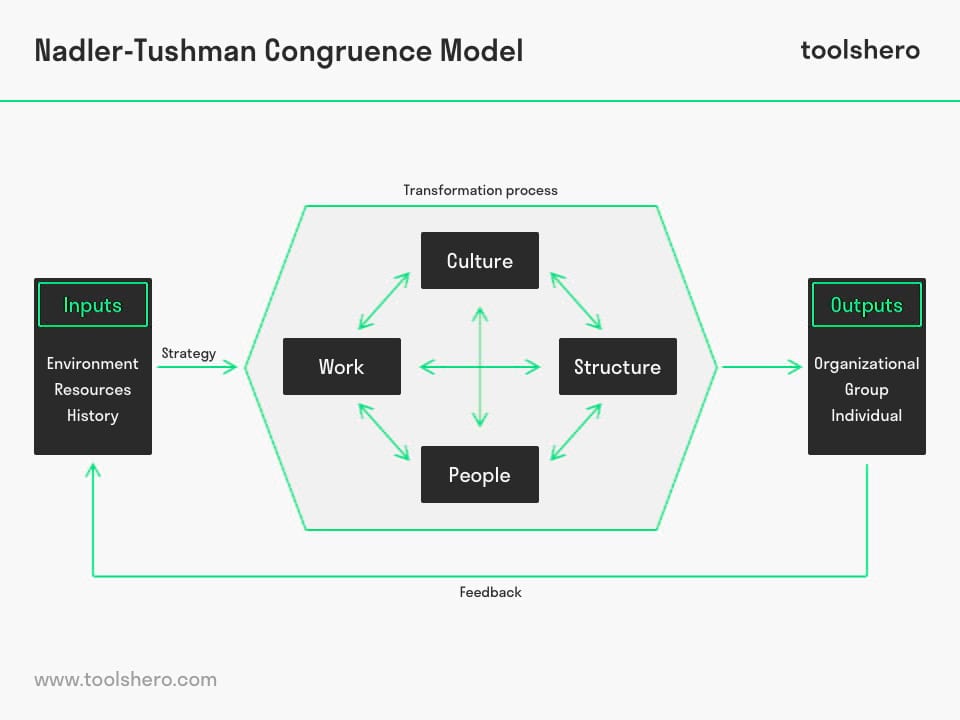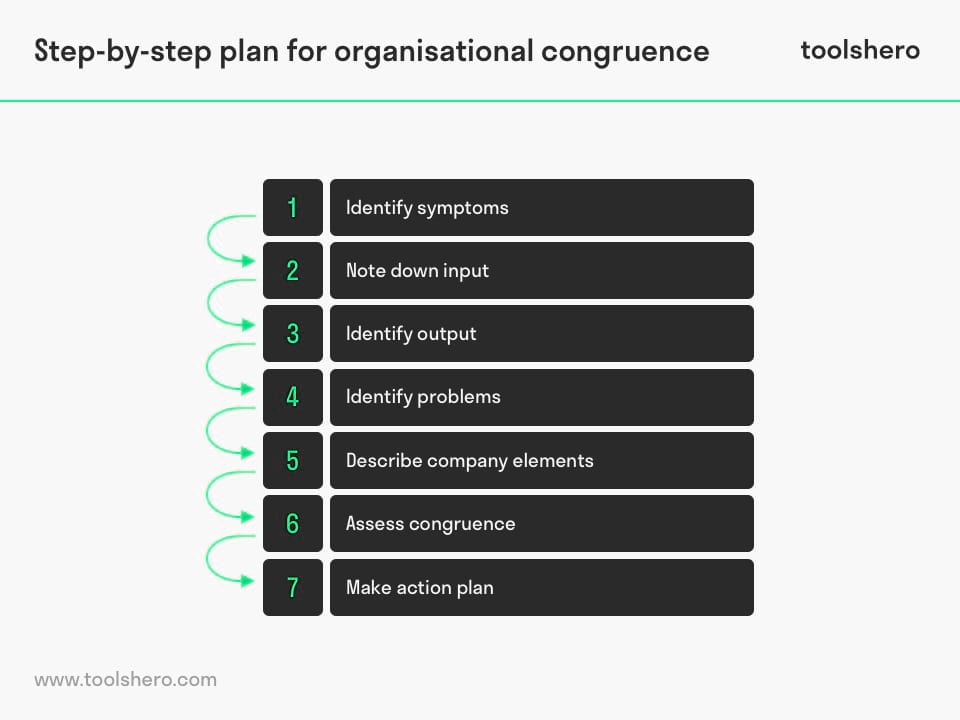Congruence Model (Nadler and Tushman)

Congruence Model for Organization Analysis: this article provides a practical explanation of the Congruence Model, developed by David A. Nadler and M.L. Tushman. Next to what it is, this article highlights also the organisation as an interacting whole and a step-by-step plan for organisational congruence. After reading, you’ll understand the basics of this management tool. Enjoy reading!
What is the Congruence Model for Organization Analysis? The theory
The Nadler-Tushman Congruence Model for Organization Analysis is a diagnostic tool for organisations that evaluates how well the various elements within these organisations work together. The result is the identification of performance gaps. These gaps have to be closed in order to improve the organisation’s productivity and profitability.
The gaps are identified because the Congruence Model for Organization Analysis looks at the way the company processes information and input from both internal and external sources. Furthermore, it analyses communication structures to make them process the information as effectively as possible.
Thise todel is based on four elements. These elements are work, people, structure, and culture. According to this model, then, an organisation’s performance is the result of the way these elements work together. The Congruence Model for Organization Analysis provides a step-by-step plan with six steps. This step-by-step plan, further explained in this article, can be used to identify a performance gap.
This allows you to compare the current situation with the desired situation and forms an important first step in developing a concrete strategy in order to close the performance gap. The goal and result of this model is to realign company activities so that everyone strives for the same goal.

Figure 1 – Example of the Congruence Model
The Congruence Model for Organization Analysis was developed by David A. Nadler and M.L. Tushman in the 1980s.
Nadler was a successful theoretician and consultant, while Tushman is still Professor of Business Administration at Harvard University.
Congruence Model: the Organisation As an Interacting Whole
As can be seen from the image, an organisation in fact consists of four elements that work together in order to process input into output. This process is referred to as the transformation process: natural resources, components or other means are processed and turned into something new. This includes the financial means, used to purchase all the other means.
This transformation process takes place continuously within the organisation. The organisation’s environment is not as stable. Organisations are exposed to countless threats and opportunities and need to use their means in such a way as to achieve maximum profitability.
Threats and opportunities can be identified using the SWOT model. Other environmental factors can be identified using PESTLE.
The finished products or services are then delivered to the external market. The market’s reaction is important to the organisation, which will always consider and process it in the form of feedback. The transformation process itself, which can be made more efficient using the Nadler-Tushman Congruence Model, consists of the following four elements.
Work
Work refers to the tasks carried out by employees. It’s important that the result of these tasks are aimed at the company objectives. It should be apparent which skills or knowledge are required for tasks and company activities, and these should be present to a sufficient degree within the organisation.
People
People are an important part of the organisation and the congruence within it, and form an important part of the Nadler-Tushman Congruence Model.
A company aimed at innovation is looking for pioneering, fast-thinking people. A sales company is mostly focused on finding sales talent.
It should be known of employees which skills and knowledge they possess, whether they have experience, and what education they have followed. It should also be known how they would like to be individually rewarded and compensated for their work. For motivated staff, it’s also important that they should be able to develop potential within themselves.
Structure
Although aligning the work from the first of the four elements is important, aligning the organisational structure is even more important.
Structure is the third component of the Nadler-Tushman Congruence Model. It creates consistency between what an organisation wants and what it does.
A company that responds to new market developments needs a flexible corporate structure that is able to quickly adjust to the changing market. A company chain with outlets in various regions would benefit more from a hierarchical structure with regional managers.
Culture
The corporate culture consists of values and norms, behavioural patterns and rules, both written and unwritten.
The corporate culture also has great influence on the way it supports and stimulates the corporate results.
Sometimes, an organisation’s culture needs to change before the organisation is able to adjust to a new business focus. A relaxed, informal corporate culture may work well for a startup, but will need to become somewhat more mechanical upon growth.
There are also organisations where the focus is on employees and their well-being. This happens in altruistic organisations.
Congruence Model for Organization Analysis, a Step-by-step plan
We may derive several steps from the Congruence Model for Organization Analysis, which can be gone through in order to achieve congruence and improved performance in the organisation.
The first step of the Congruence Model for Organization Analysis will not need to be gone through by every user. Reasons for carrying out such a process may vary. Sometimes a performance gap is suspected and the organisation wants to run an analysis in order to be sure. When there is no suspicion of incongruence, the step-by-step plan may still be gone through in order to improve any inefficiencies.

Figure 2 – The steps to perform an organizational analysis in relation to the Congruence Model
1. Identify symptoms
Collect data that show possible failings in the organisation’s functioning. These may be disappointing results, undesirable behaviour on the part of employees, or something else. Make sure all symptoms are noted down.
2. Note down input
Investigate the exact means used in the organisation. Consider the organisation’s environment in the assessment as well, and note down important aspects relating to financial input, human resources, and history.
3. Identify output
Then, identify what the organisation is producing as its output on various levels. Investigate individual, departmental, and organisational performance. In the next step, compare the performances achieved to the desired performances.
4. Identify problems
Assessing and comparing performance, one may find various causes for problems. In this step of the Nadler-Tushman Congruence Model, use the root cause analysis to identify the causes.
It’s important to compare the results achieved to the desired results, as well as selecting areas where the difference is substantial. For each problem, the consequences it brings should be noted down. This means direct costs, indirect costs, and opportunity costs.
5. Describe company elements
In this step of the Nadler-Tushman Congruence Model, the four elements explained above are described. Make sure the descriptions are clear, concrete, and focused on the element’s core functions. If needed, use corporate models like the Business Model Canvas.
6. Assess congruence
Assess the relative congruence between the various elements of the company. Think of how information streams flow, what the communication structure looks like, who has been invested with which powers, and which people are responsible.
Carefully consider the various ways in which the elements interact. Tasks and people, people and cultures, structure and culture, they all relate to one another and may provide useful insights into the manner and degree of efficiency of working.
7. Make action plan
Note down how the problems from step 4 of the Nadler-Tushman Congruence Model may be anticipated and how problems should be dealt with in the future. By linking the problems to output and finding out what’s causing the discongruence, the exact cause may be traced.
Then, use Business Process Re-engineering (BPR) in order to reshape the processes.
Now it’s your turn
What do you think? Are you familiar with the explanation of the Nadler-Tushman Congruence Model? Have you encountered the model before. If not, would you now use the model yourself? What else do you think is important in order to keep an organisation running smoothly? Do you have any tips or additional comments?
Share your experience and knowledge in the comments box below.
More information
- Nadler, D., & Tushman, M. L. (1980). A congruence model for diagnosing organizational behavior. Resource book in macro organizational behavior, 30-49.
- Nadler, D. A., & Tushman, M. L. (1980). A congruence model for organizational assessment. Organizational assessment: Perspectives on the measurement of organizational behavior and the quality of work life, 261, 278.
- Nadler, D. A., & Tushman, M. L. (1980). A model for diagnosing organizational behavior. Organizational Dynamics, 9(2), 35-51.
- Nadler, D., Tushman, M., Tushman, M. L., & Nadler, M. B. (1997). Competing by design: The power of organizational architecture. Oxford University Press.
- Tushman, M., & Nadler, D. (1986). Organizing for innovation. California management review, 28(3), 74-92.
How to cite this article:
Janse, B. (2019). Congruence Model (Nadler and Tushman). Retrieved [insert date] from Toolshero: https://www.toolshero.com/management/nadler-tushman-congruence-model/
Published on: 03/08/2019 | Last update: 03/02/2023</p
Add a link to this page on your website:
<a href=”https://www.toolshero.com/management/nadler-tushman-congruence-model/”>Toolshero: Congruence Model (Nadler and Tushman)</a>












